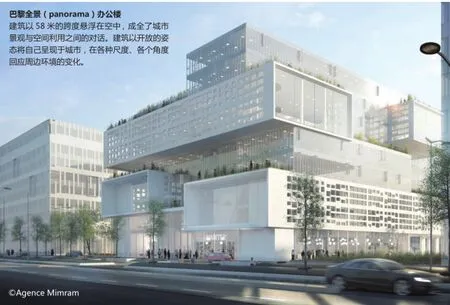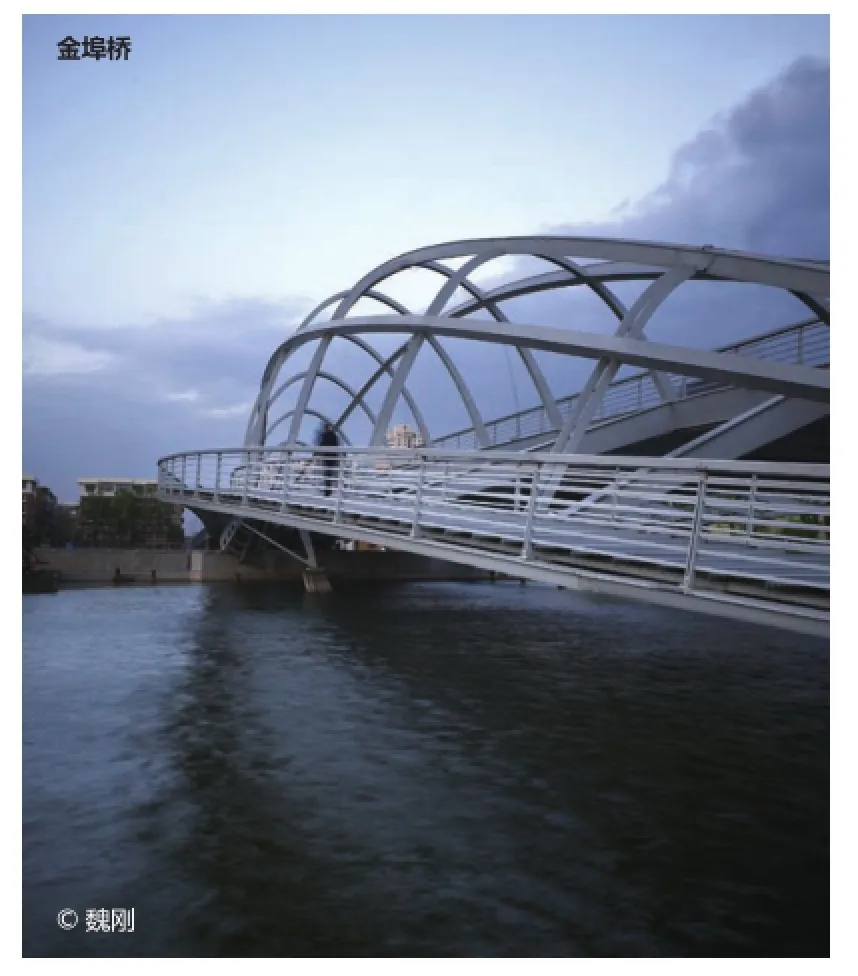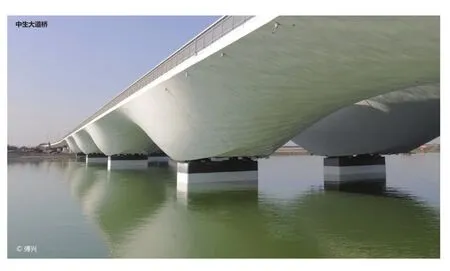PERSONAGE OF THE EDITION本期人物:马克·米姆拉姆
2015-09-01刘晓燕
PERSONAGE OF THE EDITION本期人物:马克·米姆拉姆
责任编辑:刘晓燕
简介
马克· 米姆拉姆先生1955 年出生于巴黎,先后就读于巴黎一大(先贤祠-索邦大学)、巴黎国家路桥学院、加利福尼亚大学伯克利分校(美国)等高校,获得数学、哲学,以及建筑学和结构工程的硕士学位。在2000 年到2010年期间获得了法国最高荣誉骑士勋章、国家功勋骑士勋章和文学艺术骑士勋章。
自1981年开始,马克·米姆拉姆先生创立了自己的事务所,以建筑师和结构工程师的身份,基于建筑美学与结构力学的融合,在法国和其他一些国家开展了大量建筑物与构筑物的设计。其中最为人称道的有:巴黎Solferino人行桥,这个作品获得了1999年银角尺奖;巴黎Eprunes高速公路收费站获得1995年银角尺奖提名;摩洛哥拉巴特的哈桑二世桥获得2013年Aga Khan建筑奖;在法德边境连结斯特拉斯堡和科尔的人行桥,获得2005年雷诺交通设计奖。此外,还有许多作品都获得好评,如中国天津直沽桥(原名奉化桥)、金埠桥(原名蚌埠桥)、宁波的外滩桥等。
马克·米姆拉姆先生还有很多文化、体育建筑创作成果,如巴黎19区的Pailleron游泳馆-滑冰馆、斯特拉斯堡国立高等建筑学院、巴黎罗兰加洛斯网球场、巴黎13区的Panorama办公楼、波尔多Flot的公寓、Portel的体育馆等。
马克·米姆拉姆先生先后任教于国家路桥学院、洛桑联邦理工学院及美国普林斯顿大学, 目前在法国 Marne-la-Vallee 建筑设计学院任教授。
Born in Paris in 1955, Marc Mimram holds a Master's Degree in Mathematics and graduated as an engineer from the « Ecole Nationale des Ponts et Chaussees ». He is a DPLG Architect and holds a Master's in Civil Engineering from the University of Berkeley in California in addition to a post-graduate degree in Philosophy. He got honors of Chevalier de la Légion d’honneur, Chevalier de l’Ordre National du Mérite and Chevalier des Arts et des Lettres between 2000 and 2010.
He founded his own consultancy and architecture-engineering frm in 1981 and has completed a large number of civil engineering structures and architectur¬al projects in France and abroad. The main projects are Solferino Footbridge in Paris 1999 (« Equerre d'argent » special award), Feng Hua an Beng Bu Bridges in Tianjin, China (2006-2007), the Eprunes toll station 1994 (« Equerre d'argent »special award), Ningbo bridge in China 2008, Footbridge over the Rhine between Strasbourg and Kehl 2004 (Renault Traffc Design Award), Hassan II bridge in Rabat, Morocco 2011 (Aga Khan Award for Architecture 2013).
He has built a large number of sport and cultural facilities as Pailleron swimming pool-skating rink in Paris (2007), or the School of Architecture in Strasbourg (2013), and is presently developing the project for the Roland Garros Tennis interna¬tional tournament in Paris, the " Panorama" offce building inhabited bridge in Paris, the housing program in Bordeaux and the sport facilitie in Le Portel.
Marc Mimram taught at the « Ecole Nationale des Ponts et Chaussees », at the Ecole Polytechnique Federal de Lausanne, and at Princeton University (USA). He was appointed as Professor of Architectural Schools and currently teaches at the « Ecole d'Architecture de Marne-la-Vallee » near Paris.

设计理念
马克·米姆拉姆先生的作品注重建筑学与工程学的紧密结合,以形成体现工程美学、融合地域文化的结构精美的建筑作品。
他坚信建筑美学没有独立存在的价值。对于一个建设项目来说,工程的实施与设计方案同样重要。因此, 做项目的过程依靠的是各专业的协同作业,这是一个汇聚各类元素、信息和技术,并将其转变、演化为建筑语汇的繁复过程。
这个演化过程最初体现于物质元素:从矿石的开采到钢板的轧制、从原木的采伐到木结构的加工、从石料的粉碎到钢筋混凝土框架的建成,从铝土矿的开采到铝制型材的成型——来自广袤大地的物质元素通过加工进入了以建造为中心的演化过程。
当然,设计本身也是演化的表征:通过围绕“外形方案—结构计算—施工图”三部曲所做的种种理性思考、选择,项目设计成为了空间演化的理性工具。
对构筑物和市政基础设施建设项目来说,项目的定位至关重要。尤其是对待那些大规模的建设项目,一定要避免技术至上的观点。桥梁不只是一种连接通道,道路也不仅仅是承载川流不息的交通流的沥青带。
项目设计必须与当地的背景(历史、文化、自然环境)相契合。因此,桥梁便是横跨河流之上的散步露台, 道路便是可以浏览当地风貌的长廊。
过去,我们在建设上只争朝夕,认为时间的价值远高于环境因素。在时间上争分夺秒意味着丧失与环境的和谐关系,肆意妄为,忘记了项目所依附的根基。如今,我们必须避免走此老路。
为避免昨日的错误,我们在项目设计这个演化过程中不能只关注技术价值,而是要悉心考量项目的环境景观设计、基于结构美学的建筑设计以及高品质共享空间的营造等。
就像用精确枯燥的数学图像来解读一个区域或一个城市的构思与想法,对某些人来说是毫无头绪的一团乱麻,对另一些人来说则是地理认知的暂时失真,在大多数人看来,都是非常虚拟与抽象的概念 。
恰恰相反,只有认真研究项目的环境,充分利用自然光线,根据当地的实际情况,把握和发挥好材料特性,体现结构美学,才能够创作出融于当地环境的设计作品。


Our work is concerned as much with the architecture as with the conception of structures: constructed structures, those of structural works and of territorial development.
We have always considered that architecture cannot remove itself from the feld of construction and that the execution is equally a determinant for a project as is its conception: The project therefore becoming the accumulation of a shared work, the construction site a place of memory, and the construction a vast process of transformation.
This transformation fnds its origin in the very use of the material: from ore extraction to steel sheet manufacturing, from logging to laminated wooden structures, from quarry crushing to reinforced concrete frames, from bauxite mining to extruded aluminium sections. Everywhere, the great countryside is moulded by this industrial process that places construction at the centre of this transformation.
But the project is also an indicator of this transformation; Grounding itself on the rationality of the choices organized around a trilogy – geometry – statics – construction, the project becomes a reasoned tool for the transformation of space.
In the feld of structural work and that of infrastructures, the description of the project is most determining. It must avoid the technocratic abstractions in which large-scale projects are built in the actual field. A bridge is not just a connection, a road not only an asphalt stripe accommodating a migratory traffc.
Here, the project must also fnd its coherence in the study of the local scale, in the course of an informed historical geography. Thus, the bridge becomes a balcony for a stroll on the river, the road a passage through the textures of geography.
Yesterday, construction was done for the greatest number; today we build to avoid it: the value of time takes precedence over geography. Gaining time seems to signify losing a relationship with the earth, to be extraterritorial: a dematerialization occurs.
To avoid the errors of yesterday, it is necessary that these major transformations not be reduced to their technical values; we have to fnd the qualities that are sensible to the consideration of the project’s landscape, the constructed qualities of structural works, and the qualities sharing the public forum.
Thoughts of the city, like those of the country seem to be removed in mathematical imagery: chaos for some, temporal anamorphosis of geography for others, virtual network for all.
Conversely, it is the attention to places, the value of light, and the pleasures of gravity and material that are put in place that assure the generosity of shared space.
访谈:马克·米姆拉姆
导报:米姆拉姆先生,您在中国做项目有多久了?
马克·米姆拉姆:很早之前就来过中国,但是在这里开展工作大概有12年左右。实际上,来中国的目的,不是仅仅做几个项目,而是一个长期的交流过程。我所感兴趣的是了解中国的方式,做设计的方式,施工的技术,然后将自己的设计理念与中国实际结合,在当地生根。
设计并不只是完成一项任务,而是要全面了解项目的状况,深入理解场地的条件和景观的需求,更重要的是人们对使用它的要求。我将外界所有的要求融合到设计中,一同实现。
导报:能不能谈谈您对于中国建筑的看法?
马克·米姆拉姆:中国建筑业的现状很有吸引力,也富于挑战。两个方面:一方面是数量,中国需要很大的建设量,这给专业人士提供了很好的机会和宽松的创作环境;另一个方面是质量,在如此快速的土地开发和房屋建设的同时,需要十分谨慎地从事建筑设计。现在存在两种极端,一是过于追求“现代”,不要任何限制;另一个是照搬传统的形式或符号,这两种倾向都不大可取。导报:您了解了一些中国的方式,那么能否为我们介绍一下法国的方式?
马克·米姆拉姆:首先谈中国,中国的建造方式很特别,这其中有优势,也有缺点。比如,在中国,劳动力充足,且勤劳、智慧,人工成本相对较低,使得建筑师对建筑材料和施工工艺有了更多的选择。例如,钢筋混凝土,在欧洲工厂预制后运输到现场安装相对经济,而在中国,多数情况下现浇混凝土更便宜。了解到这些区别之后,在中国的项目中就有所体现,考虑利用哪些当地的优势条件,更利于实现作品。
对比法国,其实建筑创作与作品的实现的过程大同小异,但是着眼点略有不同。比如,在法国,更看重质量,而不太关心速度和数量。具体体现为:对于设计和建设都有合理的周期保障,不会超常地压缩时间;对于外观造型的要求,并不是各方面甄选方案所最关注的因素,更加重视的是建设工程对周边环境所带来的影响。对于环境的尊重被放到极其重要的地位。这种尊重,不仅仅体现在对绿化、植物的保护,也包括了对材料、能源的节约,对现有城市肌理的延续,维系与周边城市空间的和谐关系,还包括对人文生态方面因素的考量。
煤,它来自土地,建筑学的所有工作就是将来自地球的物质一点点转换为材料,然后转换为建筑,最终又融合于大地,而不是留下一堆垃圾。建筑学是转换的艺术。阳光、山、水、土地、能源,都是地球的一部分,是做设计的基本条件。做设计不能眼睛只盯着外形,而是要考虑到环境、建造过程(即如何实现)、施工技术等所有要素。建筑学是交流、对话,而不是自我表现。导报:您自身的受教育背景非常复杂,您是如何从工程领域涉入建筑的?
马克·米姆拉姆:工程与建筑并不对立,但是现实中,无论是中国还是法国,工程师和建筑师都是站在各自的角度上看问题。如果能够实现二者的融合是最理想的。我自己现在同时在两个学校担任教职,一个是路桥学院的结构工程教授,另一个是建筑学院的建筑学教授。我会特意安排这两个学院的学生一同上课,一起做课题,最终提交的设计成果中既包含设计作品的展示,也包括结构计算书。就是说,从一开始就让不同专业背景的人一同做项目,渐渐他们的视野就打开了,能够理解合作伙伴的创作基点和思维方式,进入实际工作阶段后,与相关专业的协作就顺畅了。现在这种趋势越来明显。
导报:整体而言,法国的建筑教育的侧重点是什么?
马克·米姆拉姆:整合。法国建筑教育一直在教的是整合众多因素去形成设计。汇集各种信息,在你这里,去产生一个好的项目。比如手机,它的设计制造过程很复杂,但是到了用户那里就变得很简单,直接打电话就好。比如设计一座桥,使用者仅仅是从这头走到那头,但是对于设计师来说,需要考虑的因素却非常多。人与天空、水面的关系,公共空间的营造,与环境的结合,桥需要成为一个对话的枢纽,与景观对话,与材料对话,与人对话,与历史对话,最终是一个整合的结果。


